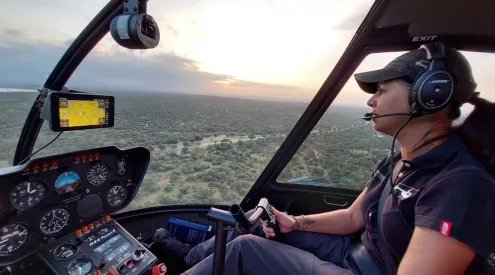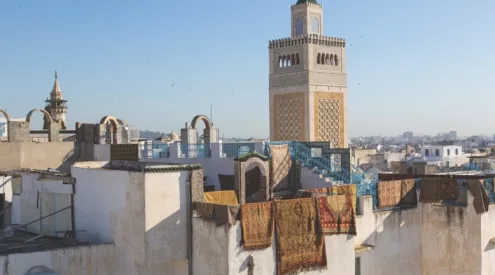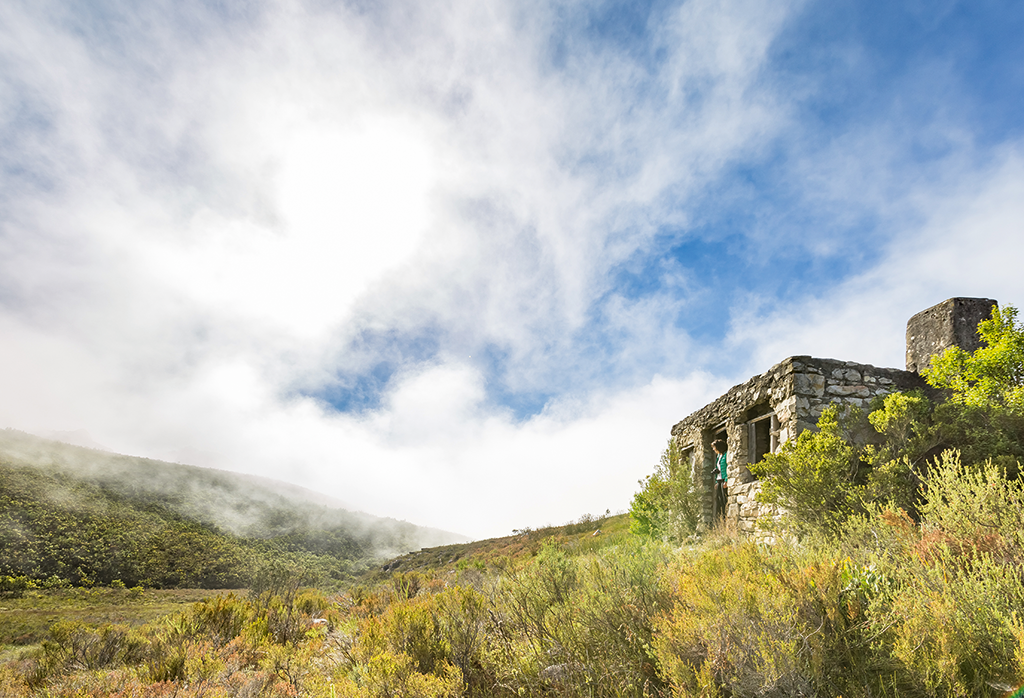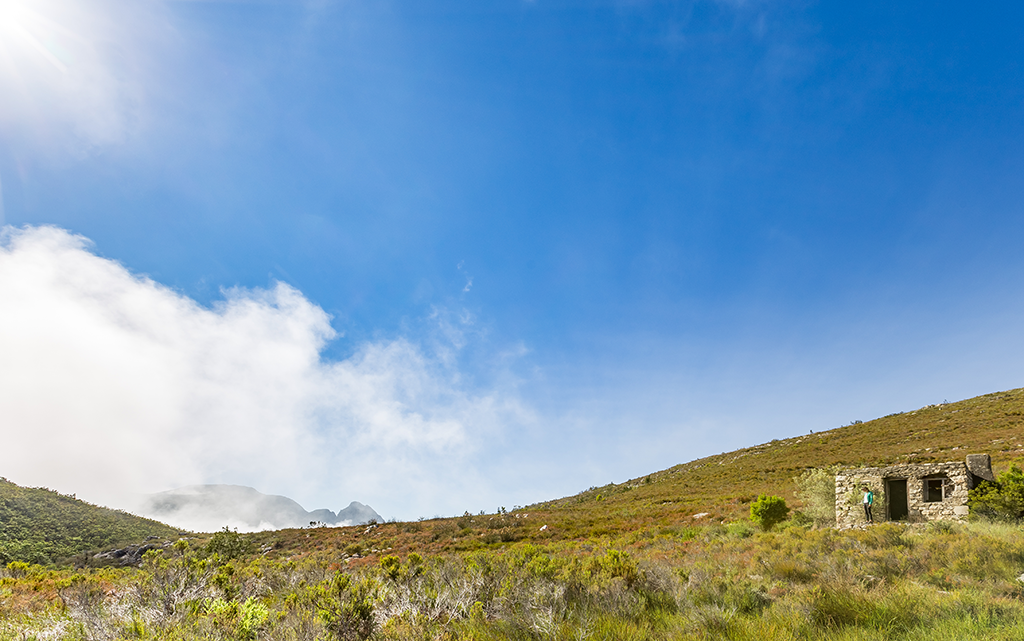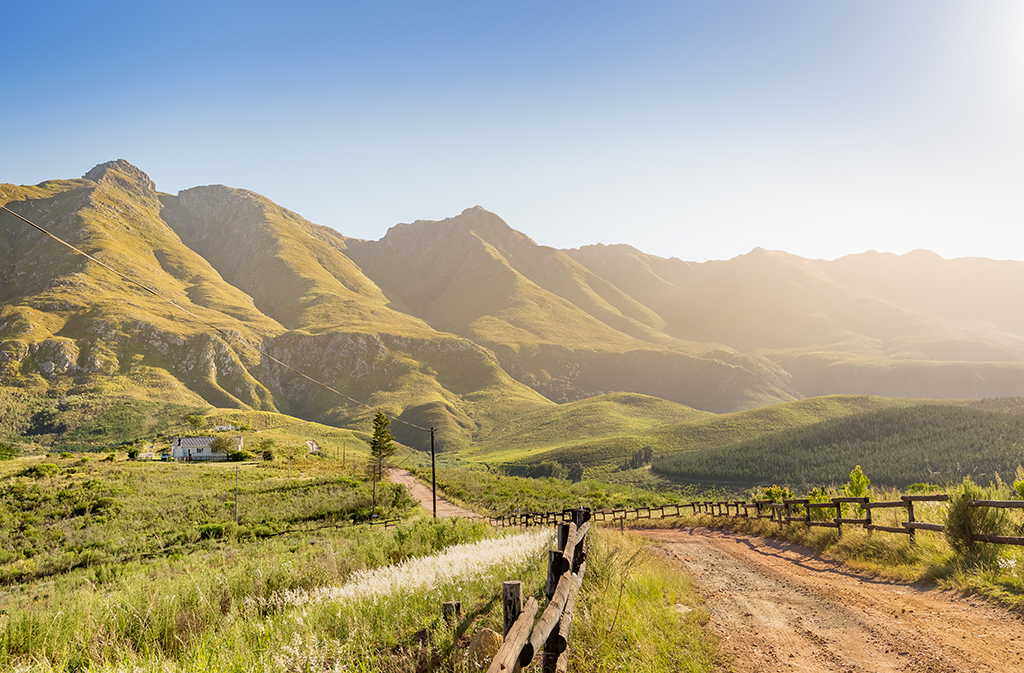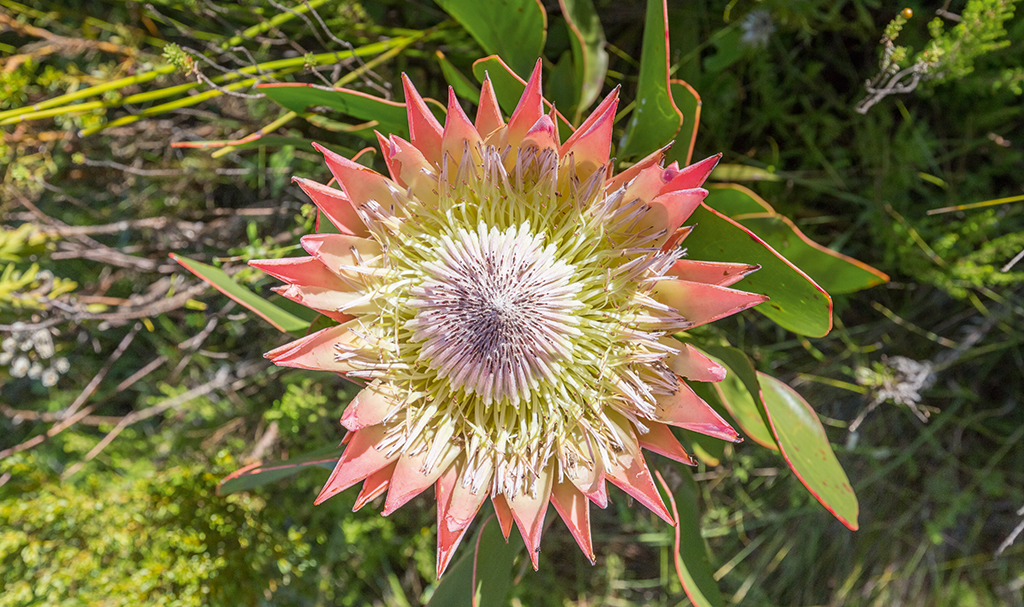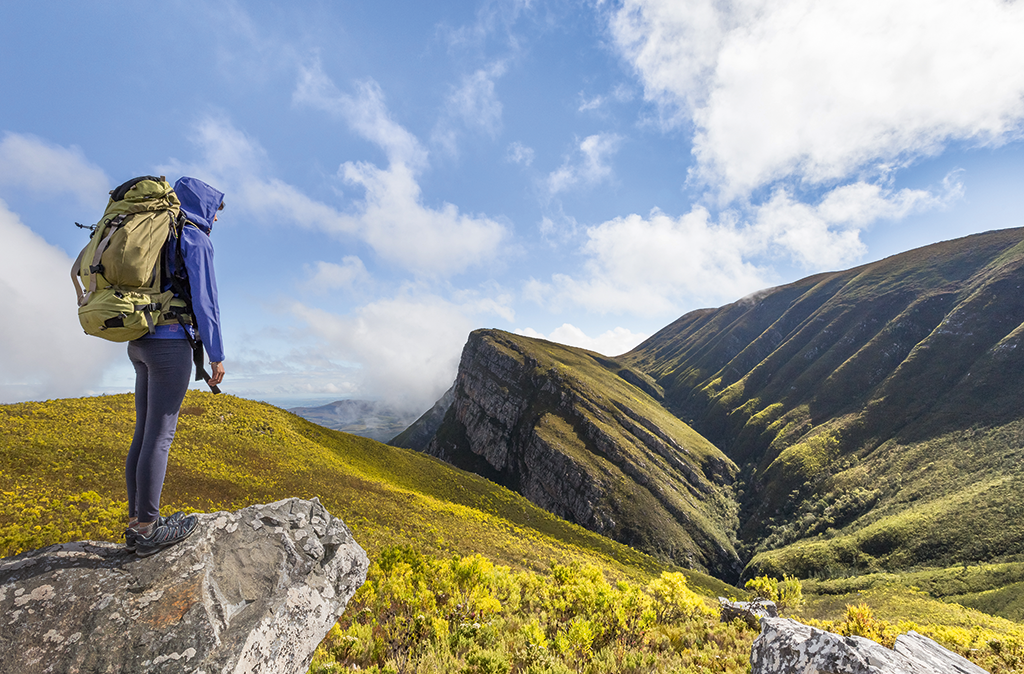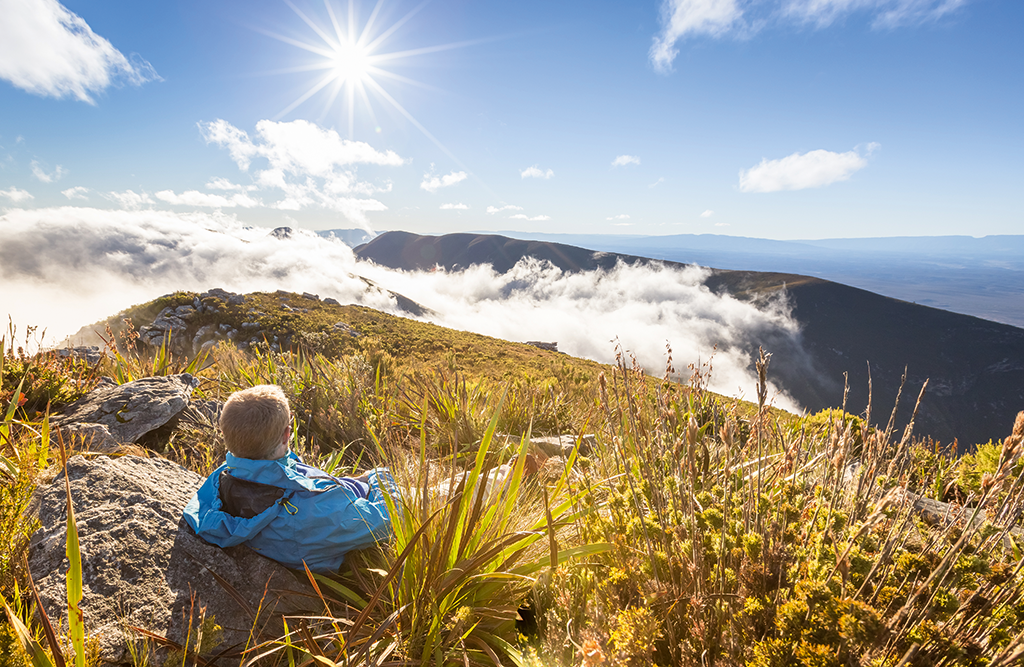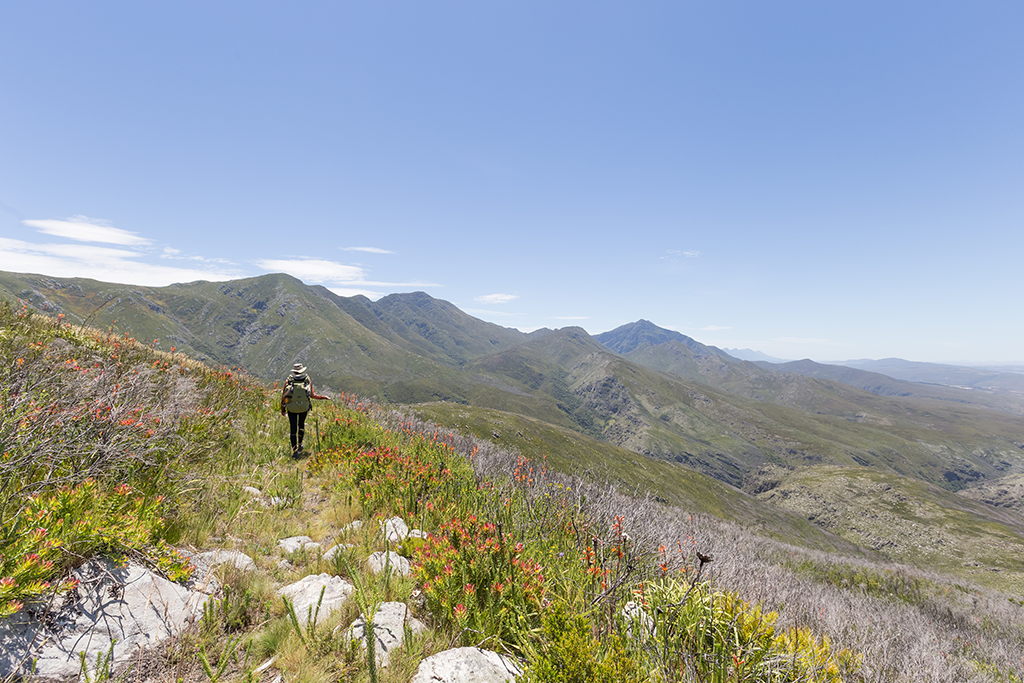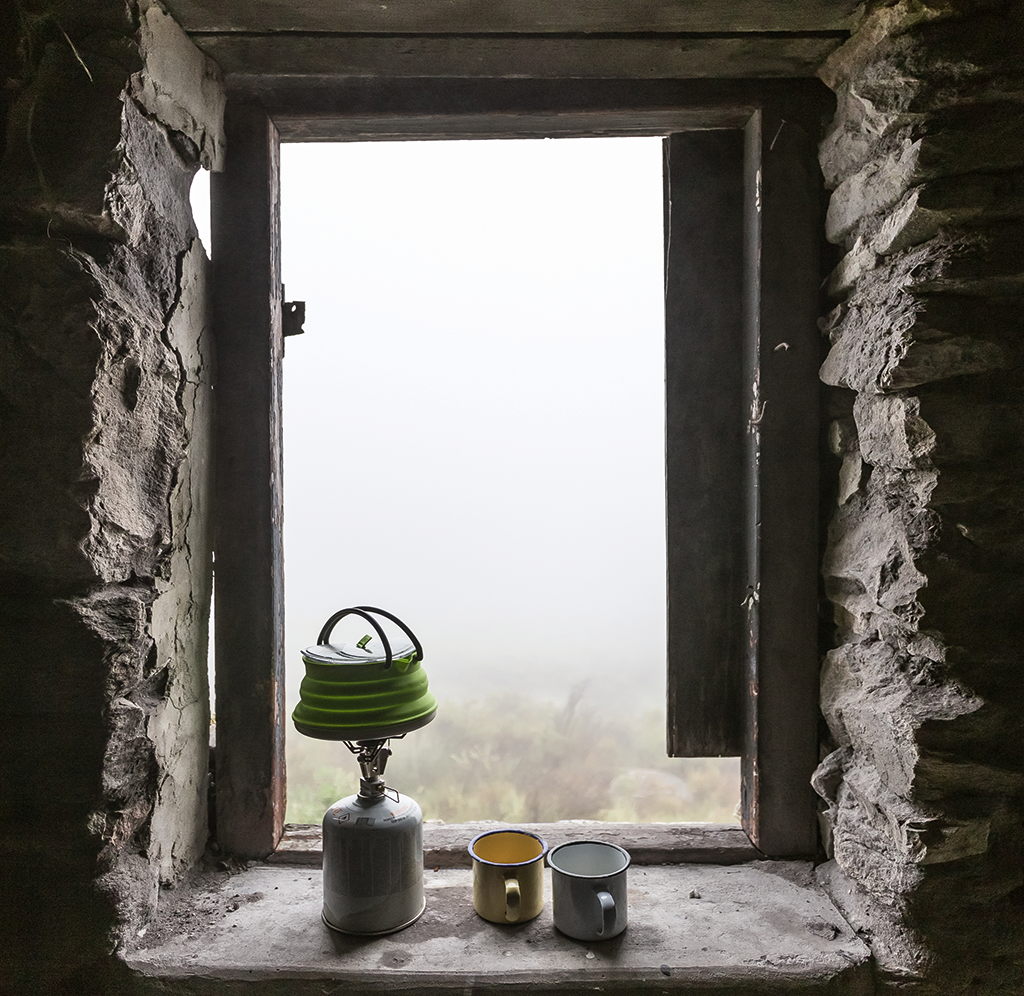The Langeberg is one of South Africa’s most beautiful ranges, and it’s even better up close, on foot. Use this guide to create your own five- or seven-day hiking road trip.
Drive the southern Langeberg in the late afternoon and it’s easy to believe it’s the most beautiful stretch of mountain in the country. For 250 kilometres, from Worcester to Mossel Bay, the procession of peaks runs at a near-perfect east-west, and light glances off those south-facing slopes in a way that may be unique in South Africa. And not just because of their orientation.
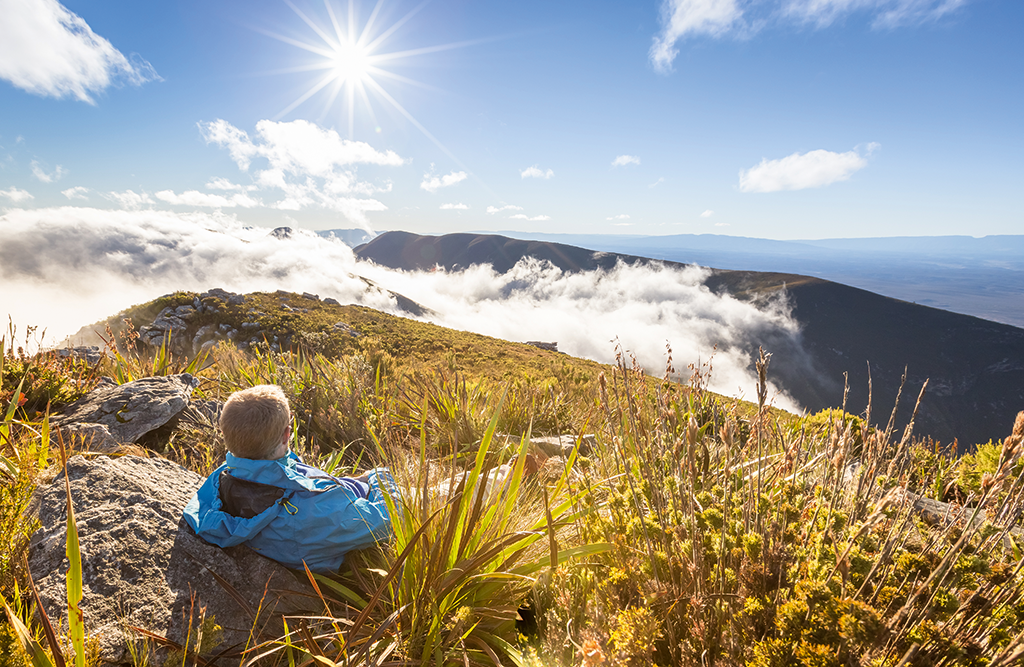
The view of the Klein Karoo to the Overberg from Sleeping Beauty peak is absolutely worth the steep hike up. Photo by Chris Davies.
This length of the Cape Fold Mountains forms a watershed so hard to breach that while some south-facing sections receive some of our highest average rainfall, a few kilometres north, the Klein Karoo lies brown and parched, doing the best it can with the leftovers.
Swellendam, Suurbraak, Riversdale. Even the towns – which are far more prolific on this southern side of the range – evoke images of water. As you leave the N1 and follow the R60 east, soft, green slopes rise to your left and you pass one vineyard after another, then dairy farms and their grassy fields, signs for Leeurivier and Fonteinskloof speeding by. With the sun at your back, the foothills fan out ahead – round, fynbos-covered mounds with darkening kloofs between.
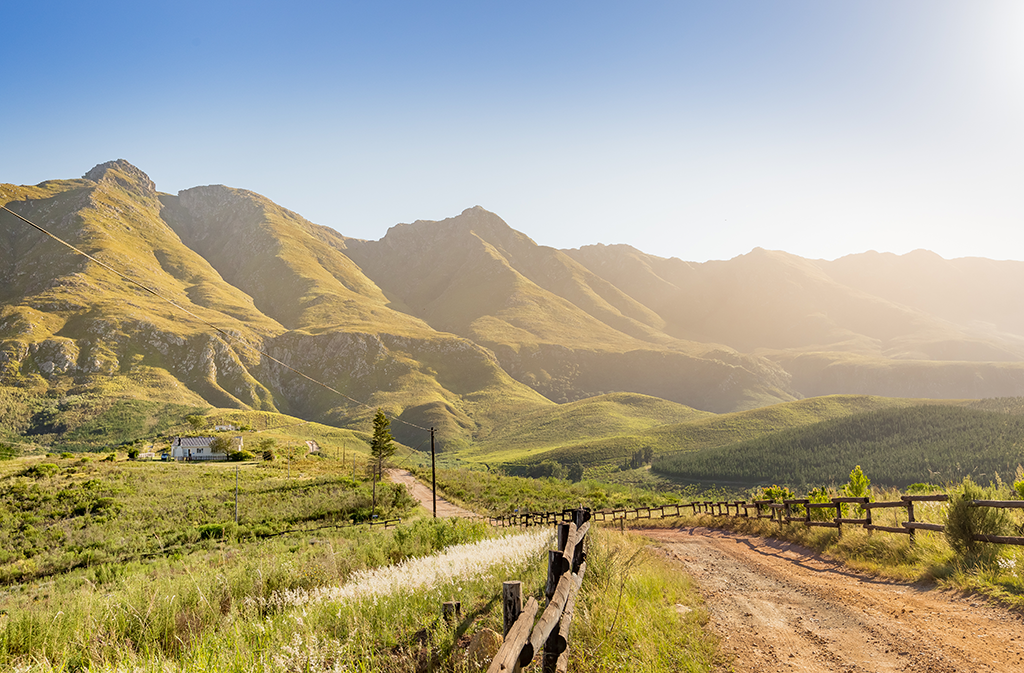
Bushbuck Cottage is an excellent base for exploring the hidden kloofs of Marloth Nature Reserve. Photo by Chris Davies.
Arriving at Marloth Nature Reserve for the first overnight stop, the mountains seem higher, now that they’re so close. The last of the sun’s rays catch the tops of the so-called ‘Clock Peaks’ – Een-, Twaalf-, Elf- and Tienuur spread out evenly above. Their summits glow a brief pink, and then it’s only the light from the braai that casts flickering shadows on the cottage wall.
Sunrise the next day reveals the same glory in reverse. Yellows and golds replace last night’s pinks and reds, and by the time the sun’s climbed high over Twaalfuur peak, we’ve clambered up a densely thicketed gorge where a waterfall keeps an inviting pool clean and fresh. Only when up close do we see how green these mountains are in comparison with the plains below. When the rest of the Cape is experiencing the worst water crisis in years, the mountain streams of the Langeberg continue to gurgle and flow.
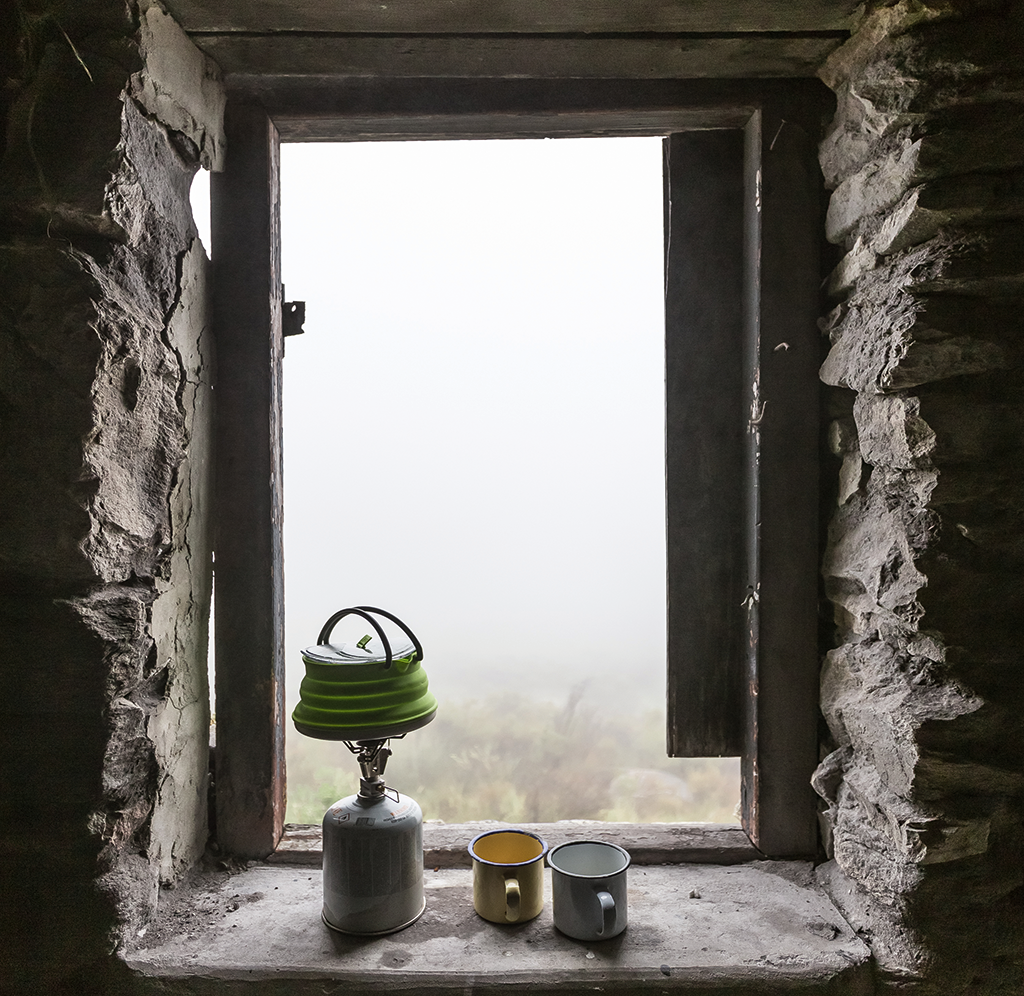
The weather changes fast in Boosmansbos – make sure you have wet-weather clothes and something hot to eat and drink. Photo by Chris Davies.
Back on the road the next morning, the diminutive Jersey cows are made even more miniature against the backdrop of peaks. After a sign to the left, to Barrydale and Tradouw Pass, the road narrows, then abruptly turns to gravel. Farmland gives way to deep stands of forest and, arriving in Grootvadersbosch a few turns later, it’s as if we’ve leapt 300 kilometres east and landed in Tsitsikamma. With a twist and a turn, the road dips beneath a thick canopy of trees, then drops us out at a clutch of brand-new timber cabins. One of these is our cosy home for the night, but just the one night. Tomorrow it’s time to get more acquainted with this protracted berg: an overnight hut in the mountain awaits.
There’s no need for an alarm clock for this early rise; no human could sleep through that explosion of birdsong. Two bushbuck scatter as we leave the cottage, then turn to regard us as we shoulder our packs and start off through the forest. Soon the trees are far below and the narrow track cuts sweeping turns into the hillside, winding up and over a cleft in the ridge. This is the Boosmansbos Wilderness Area, 14200 hectares of pristine Langeberg fynbos that sits immediately behind Grootvadersbosch, with 64 kilometres of unmarked trails for hikers to explore.
The most popular route is a two-day overnight trail to two small stone huts, about 15 kilometres into the mountains, although ‘popular’ is stretching it a bit. Few people hike these paths, and the huts are basic to say the least – mere stone shelters in an overgrown dell. A small stream provides tasty, tannin-brown drinking water, and is the only sound besides the breeze.
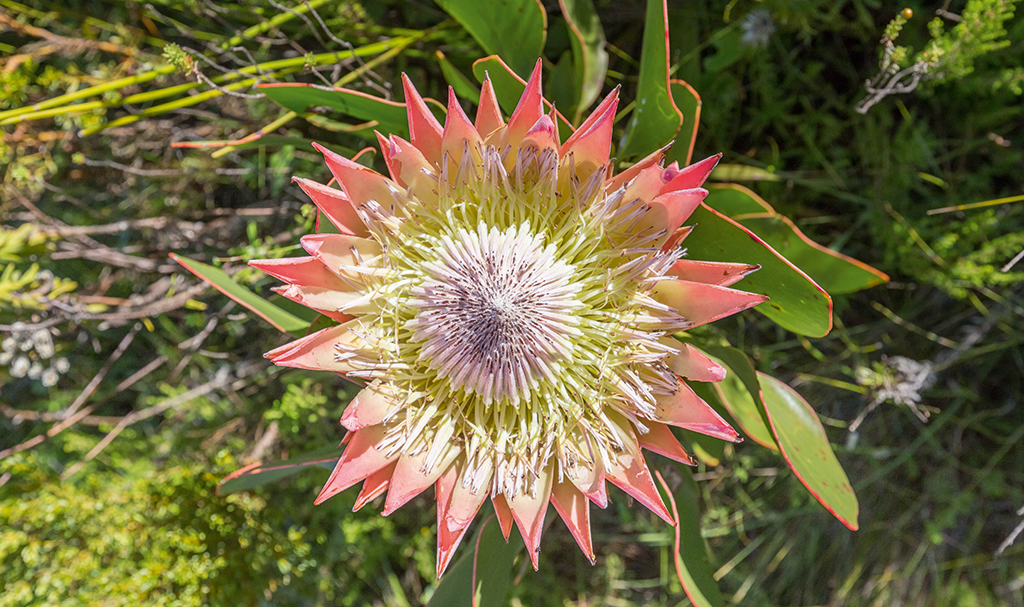
The king protea, our national flower, is just one of over 20 species of protea found in the Langeberg. Photo by Chris Davies.
The setting is simple and appropriate. Boosmansbos gets its name from a 19th-century hermit who fled society to live in these hills. Historically, mountains have long provided refuge and retreat, barriers against invaders and hideouts for raiders. From monks to bandits, anyone wishing to get away from it all could find sanctuary in mountains. These days we have few places left to do so. Mountains, because of their inaccessibility, provide some of our last remaining escapes – some of them even have bubbling streams to drink from too.
As evening draws in, a heavy fog descends with the sun. Night, when it comes, is cold and slightly eerie. Wind moans through the stones, but the hut stays snug and the rough masonry keeps the damp draught out. When morning dawns, it’s hard to tell. The light struggles to penetrate the clinging vapours. When they do go, the mist goes rapidly and, from dull grey to vivid green, the valley’s transformation is sudden and superb. Through drifting cloud, we ramble back down, and by the time we reach the Duiwenhoks River at the base of the trail, it’s hot enough for a much-needed swim, then a return to comfort in Grootvadersbosch’s excellent cabins before hitting the road tomorrow.
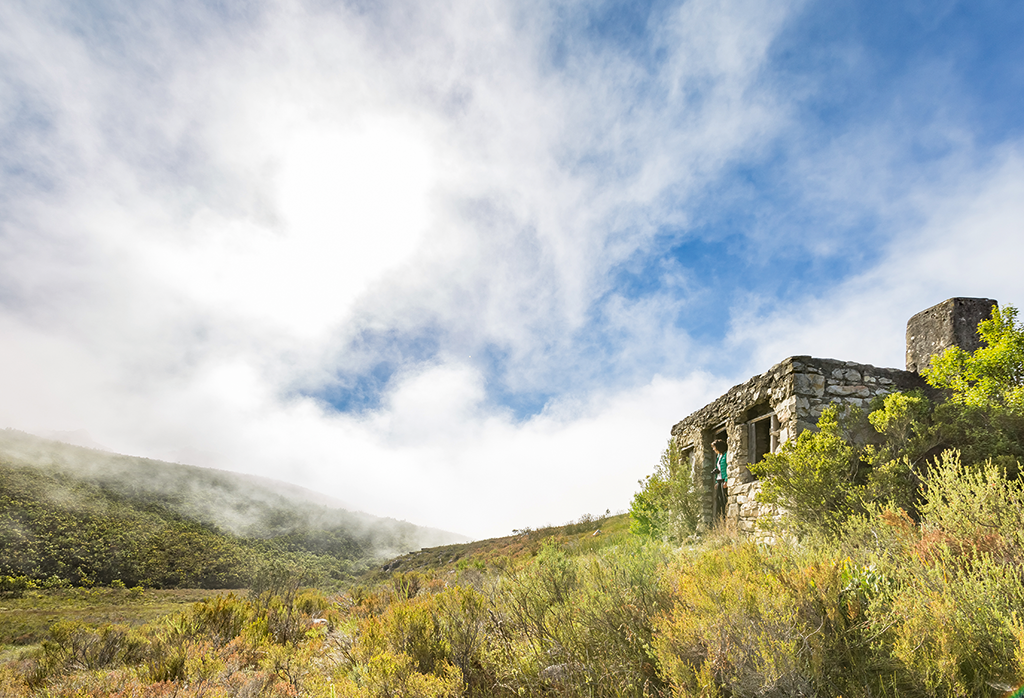
Grootvadersbosch has 11 comfortable self-catering cottages below Boosmansbos; one of the two hikers’ huts in the Boosmansbos Wilderness Area – both are very basic, little more than stone shelters against the changeable elements. Photo by Chris Davies.
Bucolic farmland lines the dirt road from Grootvadersbosch to Riversdale and an owl, startled as we stop to take in the view, bursts from cover and swoops off to find a more peaceful roost. To the north, we catch our first glimpse of Sleeping Beauty, the profile of the resting figure clearly visible this close to the range. That will be today’s challenge: a tough slog up one of the Langeberg’s most easterly summits, for the prize of this long mountain’s most wonderful view.
Through fields of leucadendrons, luminous yellow in the morning light, the trail switches back and forth until, at last, we arrive. From up here the contrast of green and tan is impossible to miss: the 360-degree panorama splits evenly north and south down the Langeberg now, the dry Karoo northwards and lush valleys south. As the sun sinks low over Worcester, the whole mountain’s length turns pink, then purple, and we turn towards home, a good meal and a comfortable bed.
Your day by day guide to the Langeberg
Do this trip in five or seven days – seven if you overnight in the Boosmansbos Wilderness Area. For a five-day trip, stay just one night at Marloth Nature Reserve, then skip the Boosmansbos overnight huts and spend the day exploring the Grootvadersbosch forest instead.
Section 1: Cape Town to Marloth Nature Reserve
Distance 250km
Allow 6 hours driving and 2 nights in the reserve
Turn off the N1 at Worcester and take the R60 towards Robertson. Turn left onto the Nuy road, then right at Nuy Winery and onto dirt. Stop at Saggy Stone brewery (1) for lunch and takeaway beers, then continue east to rejoin the tarred R60 through Robertson to Ashton. Take the R62 at Ashton for a quick detour to Cape Dried Fruit Packers (2) in Montagu. Stock up on hiking snacks, then it’s back to the R60 and east along the Langeberg to Marloth Nature Reserve (3).
Section 2: Marloth to Grootvadersbosch Nature Reserve
Distance 50km
Allow 2½ hours driving and 3 nights in the reserve
Have breakfast at Tredici (4) with beautiful Langeberg views, then take the N2 east from Swellendam before turning left to Suurbraak on the R324. Stay on the R324 through Suurbraak – it becomes the R322 to Heidelberg after the Tradouw Pass turnoff. 5km past the turnoff, the R322 becomes dirt. After another 5km, look out for the Grootvadersbosch/ Boosmansbos (5) signs on the left-hand side.
Section 3: Grootvadersbosch to Sleeping Beauty and Riversdale
Distance 110km
Allow 2½ hours driving and 1 night in Riversdale
Leave Grootvadersbosch early and stop at Delish (6) in Heidelberg for breakfast and takeaway pies for lunch. Drive the Doornkraal road north out of Heidelberg, which becomes dirt after 3km. Continue for 4km then turn right and follow the dirt east towards Riversdale, with beautiful views of Sleeping Beauty peak on your left. In Riversdale, turn left onto the tarred R323 and drive north to the start of the Sleeping Beauty Hiking Trail (7) at Garcia Pass. Hike to the summit, then it’s back down the R323 to Oakdale Cottages (8) for the last night. Cape Town is 3½ hours away along the N2.
Directory
1. Saggy Stone Brewery. Generous pub fare at reasonable prices (burgers for R80). Takeaway beers from R28 (440 ml). Try the easy-drinking California Steam. Open Friday to Monday, 11:00 to 16:00. Tel 0834533526.
2. Cape Dried Fruit Packers. Its Montagu farmstall sells low-priced dried fruits – nectarines for R43 (500g) and nuts of every description. Open seven days a week until 17:00, 15:00 on Sundays. Tel 0236141134
3. Marloth Nature Reserve. Stay two nights at Bushbuck Cottage and spend a day at Duivelsbos Waterfall or hiking one of the circular fynbos trails. The very fit can try summiting Twaalfuurkop (1450 metres) for beautiful views along the Langeberg. From R785 for four (sleeps six). R40 per person daily conservation fee. Tel 0215141410.
4. Tredici. A slice of European cuisine in Swellendam. Delicious Belgian waffle with mascarpone cheese, bacon and honey for R69. Breakfast served until 12:00. Closed Tuesdays. Tel 0285142216.
5. Grootvadersbosch Nature Reserve and Boosmansbos Wilderness Area. The 250-hectare Grootvadersbosch reserve protects the largest indigenous forest in the Langeberg, with day trails and wonderful birdlife. Book two nonconsecutive nights in a brand-new cottage (from R890 for four) and spend the middle night in a hikers’ hut in the mountains. Boosmansbos is directly north of Grootvadersbosch and the R40 per person daily conservation fee allows overnight access to two simple, stone huts. The 31-kilometre round-trip hike takes seven hours each way. There’s river water, but little else. Take everything you need with you. Tel 0214830000.
6. Delish. Here a three-egg omelette is R35 and the phenomenal takeaway pies (R30) make for a great Directory hiking lunch. Open for breakfast from 07:00 daily. 0287221850.
7. Sleeping Beauty Hiking Trail. Start at the Old Toll House on Garcia Pass. Allow seven hours for the return summit hike. At time of writing, permit fees were under review. Call Cape Nature for details. Tel 0448025300.
8. Oakdale Cottages. Cosy accommodation on a dairy farm in Riversdale. Cottages sleep up to six each. From R300 per person sharing. Tel 0824511765.
This mountain adventure first appeared in the October issue of Getaway magazine.
The best guide to weekending in Golden Gate; how to go shark diving (without a cage); exploring the high peaks of the Rwenzoris and heritage homestays with delicious food in Kerala.








